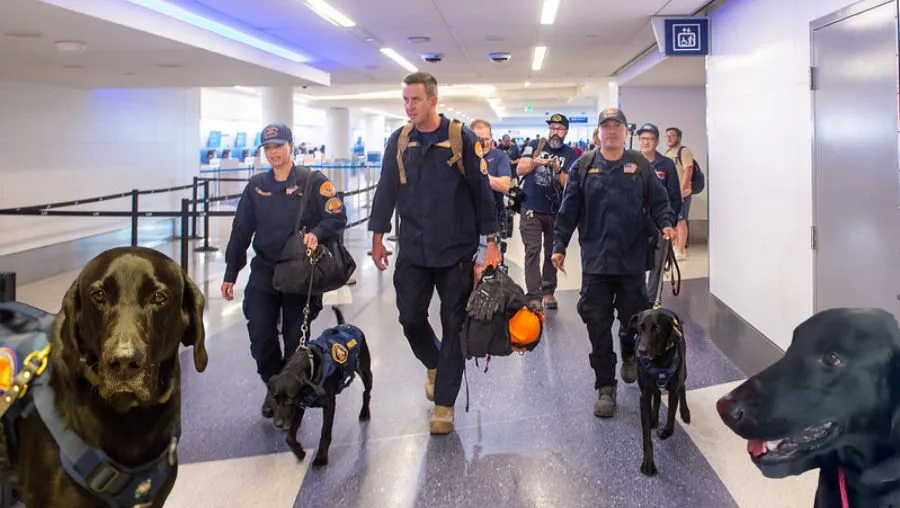They go where no human can go. They smell what no scanner can detect. And they work when the body has long since failed. In the days following the devastating floods of July 4 and 5 in Central Texas, when the Guadalupe River burst its banks and more than a hundred people were reported missing, they quietly moved to the center of rescue efforts: the rescue dogs. While helicopters circled over Kerr County, while volunteers shoveled mud and boats floated through flooded streets, a mission began for the animal search forces that pushed the boundaries of what seemed possible. Tireless, highly focused, trained for the improbable - they worked their way through debris, hillsides, and riverbanks. Always searching for a breath, a heartbeat, one final human scent. “They are fearless. They see what we no longer see. And they go where we would say, ‘No dog can get over that’ - and they say, ‘Yes. I have to go.’” - Dr. Deb Zoran, Texas A&M Veterinary Emergency Team. As early as the afternoon of July 4, the Texas A&M Veterinary Emergency Team was activated by the state command. That same day, they arrived in Kerr County - equipped with mobile veterinary stations to provide medical aid to the search dogs. It was about more than just treatment: it was about maintaining their operational readiness. Bleeding paws, dehydration, heat stress - under the conditions of a flooded disaster zone, these are not side issues but existential threats.
The deployed dogs covered up to 15 miles a day along the ravaged riverbed. They searched collapsed houses, torn-up banks, between wrecked vehicles and piles of trees. Many of them belonged to the K-9 units of Ohio Task Force 1, Minnesota Task Force One, Arizona, Tennessee, Virginia Beach, Nevada - and help came from farther away as well. “Here’s a good news story for the beginning of the week: the K-9 unit of the Los Angeles County Fire Department flew to Texas to assist in search and recovery operations following the July 4 flood. Meet Clifford - one of these rescue dogs.” Clifford, a trained rescue dog from the Los Angeles County Fire Department, was sent with his team over 2,000 kilometers to Texas - to support a search area larger than some entire states. And they did not come alone. Even from Rhode Island, a retired state trooper traveled with his K-9 partner to help. The former police team - long since out of active duty - voluntarily returned to the disaster zone because experience matters when minutes decide between life and death. “In such flood disasters,” says Dr. Zoran, “there eventually are no technical solutions left. Then you need what can’t be built: a fine nose and a loyal gaze.”


Especially in a river system like the Guadalupe River, where entire houses were swept away by the waters, where people disappeared in vehicles, basements, or rock crevices, technical equipment reached its limits. Thermal imaging cameras? They don’t work in the mud. Drones? Too imprecise in dense vegetation. GPS tracking? Useless under debris. And so it was up to the dogs - the Belgian Malinois, the Labradors, the Border Collies - to map their world through scent. Some of them worked more than 56 hours straight, with short rest periods, to locate dozens of survivors. One dog was gently covered by responders after his third day - the photo of him, exhausted, falling asleep on a piece of concrete, went around the world. It was not an image of pathos, but one of humility. The sight of a being that gave all it had to give. “The dogs find what people no longer see. Because the missing aren’t just somewhere - they’re in cars, under debris, in houses that were swept away. They’re lost in things we can no longer grasp.” - Dr. Deb Zoran. That in this mission the dogs were also cared for is not a given. With five million dollars in state funding, the Texas A&M veterinary team was able to provide the dogs with rest points, fluids, first aid, and even climate control while in the field. Mobile stations were distributed along the river - so that no dog had to travel more than five miles to the next care point. “There are lots of helicopters and drones and people walking around … but eventually, in floods like these, it all comes down to the dog’s nose.” - Dr. Zoran. What remains is not just numbers, not just search grids and coordinates. What remains is the knowledge that in the darkest hours, it is not only people who search for people - but also animals who expect nothing in return except a word, a look, a brief ‘Well done.’ And what remains may be a new understanding of what heroism means in the 21st century. Not loud. Not decorated. But four-legged, determined - and silent. Like Clifford, one of California’s best rescue dogs. Or the veteran from Rhode Island. Or all the others whose names no one knows - but whose tracks save lives.








Sie leisten großartiges in großen Krisen ❤
Toller Bericht Rainer 👍❤️
Diese Hunde und ihr menschliches Team leisten unmenschliches um doch noch Leben zu retten. Oder zumindest den Angehörigen die trauriges Gewissheit zu bringen.
Danke Rainer, dass Du diese Gelden in den Fokus gerückt hast.